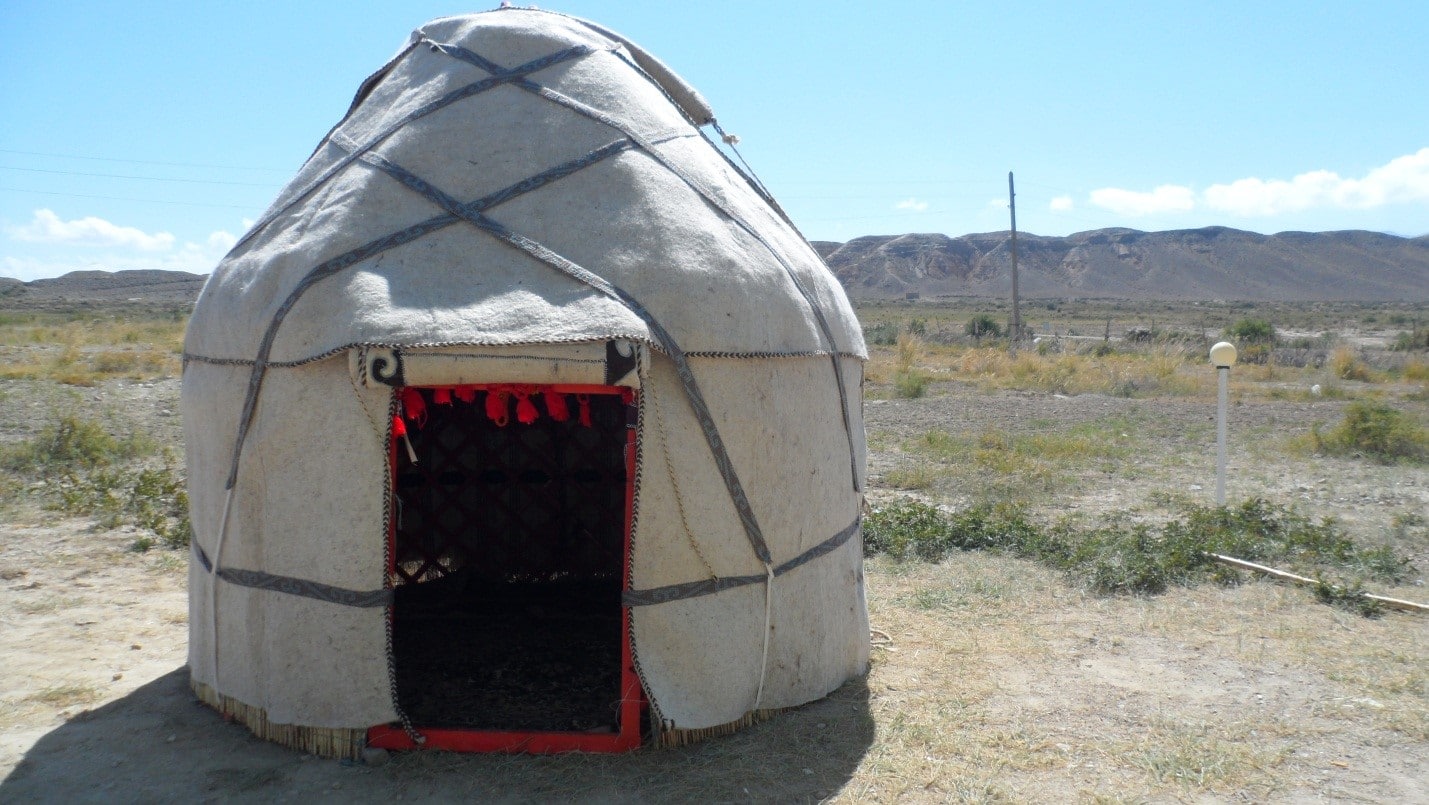Four and a half hours southeast of Kyrgyzstan’s capital, Bishkek, the village of Kyzyl-Too lies nestled in a valley about four miles from the shore of Issyk-Kul, the world’s second largest saltwater lake. With a population of only around 1500, Kyzyl-Too is known regionally – and increasingly globally – as a bastion of Kyrgyz cultural practices like yurt and felt making. These practices, in addition to keeping alive the ancient traditions of the nomadic Kyrgyz, now provide employment to a significant portion of Kyzyl-Too’s population. They are also providing additional economic benefits in promoting educational and cultural tourism to the village and surrounding area.
The Cultural and Economic Value of Yurts in Modern Kyrgyzstan

Kyrgyzstan is a Central Asian country roughly the size of South Dakota. While Kyrgyzstan has a population of over 5 ½ million, with 68.9% being ethnic Kyrgyz, Kyzyl-Too is 100% ethnically Kyrgyz. The past decade has been especially problematic for the people of Kyrgyzstan. Two revolutions, new political leaders, and ethnic and regional conflicts have all stemmed from the heritage left by the country’s Soviet past. Finding ways to constructively express the various cultures of their country has been a challenge. However, Kyzyl-Too is succeeding at this – and has gained a reputation locally as well as from international tourists and academics.
As explained to me by Almazbek Aunov, President of the Federation “Salbuurun,” an organization that promotes national Kyrgyz games and hunting techniques, the entire region surrounding this village, known as Tong Region, is well known for its very strong connection with Kyrgyz heritage and traditions.
For the nomadic Kyrgyz, the yurt, which is a form of a durable, collapsible, and easily transportable housing, has for centuries been not only a preferred shelter, but a symbol of the country and its people. While the Kyrgyz were heavily urbanized under Soviet policies of industrialization and collectivization, the symbolism of the yurt remains as important as ever. The tunduk, which forms the roof of the yurt, is inured in folkloric symbolism of unity and strength. The tunduk is featured on the Kyrgyz flag, adopted in 1992 after the nation declared independence.

There are still people in rural parts of the country who use yurts as their primary housing. Shepherds can still be found using yurts during “jai loo,” which means “good summer,” and during which large herds of sheep, cows, and horses are taken up the mountains to graze around the middle of May and led back into the valley when the weather chills around the end of autumn. Yurts can also be seen on rural roads in Kyrgyzstan, being transported by cars, trucks, or carts, though not as often as they once were.
In Kyrgyzstan, yurt making is not only a tradecraft, but a work of art. To be a master yurt, rug, or felt maker – each of whom is needed to complete a livable yurt – is something very respectable to the Kyrgyz people. In her book on Kyrgyz rugs, titled Shyrdak Dreams, Svetkul Akmatova states that:
The Kyrgyz nation is rich in such artisans, i.e. real masters of their applied folk arts, who own innate aesthetic and poetic skills. Since ancient times, there existed the artisans differing from other people in their knowledged, skillful hands and their successors will be living on in the future as well. A personal creativeness in the sphere of handicraft art is a wealth of great value.”
Yurt making has always taken painstaking effort to create a structure that is beautiful and durable; something that can be a family heirloom passed down through generations. In the past, a person was born, raised, married, and eventually died in a yurt. All important events like weddings, celebrations, and funerals were held in a yurt.
Today, a striking, concentrated number of yurt masters reside in Kyzyl-Too. A normal village might have one or two. However, as of last year, Kyzyl-Too had 102 masters. Gulai Juseva, a citizen of Kyzyl-Too and the owner of a yurt business as well as a café located on the main road around Lake Issyk-Kul, recalled that when she moved to this village in the 1970s after she was married, there were just three masters. One of these masters was her father-in-law, who then taught her husband and his younger brother the craft. Passing down tradition via apprenticeship and along family lines is a common practice in Kyrgyzstan.
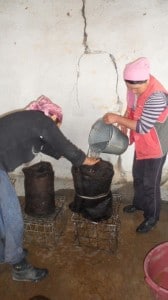
Jusaeva explained that, in the 1980s, an organization was founded in the village that taught its members the different aspects of yurt making. Thus, the townspeople were taught this trade and worked together to mass produce yurts, often with one person specialized in a specific process. The yurts were then sold in Bishkek. Thus, jobs were provided for many locals who did not have a stable income previously. After the fall of the Soviet Union, the people started making and selling yurts themselves, creating their own businesses. The industry grew. As of 2005, the town counted 65 masters. In 2012, that number had almost doubled as more people saw the cultural value in the traditions of yurt making and/or economic opportunity. A local yurt master explained to me that, over the past 5-10 years, with the rising influx of orders from buyers in Kazakhstan, Russia, Turkey, Germany, and many other countries, economic incentives for entering the trade are growing.
Many Central Asian countries, such as Kyrgyzstan, Kazakhstan, and Mongolia have similar nomadic roots and share the tradition of yurts. However, yurts come in different traditional shapes and sizes depending on what people and culture build them. As Gulai Jusaeva, one of the local yurt makers, told me: “Everywhere (in Central Asia) has yurts, for example, Mongolian yurts, they are smaller than our yurts. Kazakh yurts, they are too big. I think our yurts are compact and comfortable, which is why they have become so popular.”
Names also differ. In Kyrgyz, “yurt” is “boz ooi,” which means “grey home,” because of the natural coloring of the felt cover. In Kazakh, yurts are called “guise ooi” meaning “felt home.” Despite the differences, Kyrgyz, Kazakh, and Mongolian yurts, are all similar in that the outside will be covered in felt and there will be no nails used in holding the yurt together.
Buyers outside Central Asia use yurts for various purposes: some rent out yurts to weddings, parties, or at luxury camp grounds while some are kept for personal use as tents or even temporary homes.

As more foreigners learn about this unique cultural icon, more are also starting to travel to Kyrgyzstan to apprentice with village masters in yurt making, weaving, or felt making and to learn more about Kyrgyz culture. Jusaeva estimates the increase in foreigners visiting her local, rural area to be about fifteen to twenty percent annually. She adds that foreigners travelling on foot, by bicycle, and by motorcycle are especially common from June-August.
Official statistics support an overall growth in tourism to Kyrgyzstan, meaning that this ancient cultural icon is helping to open new doors for this landlocked, resource-poor country. USAID Local Development Program recently commissioned a survey of the tourism industry from SIAR Research and Consulting. Completed in February 2013, the survey says:
According to the data of the National Statistics Committee of KR (Kyrgyz Republic) the number of tourists vising the country is growing by the year. The share of tourists significantly decreased in 2005 and 2010 due to political events. However, in the subsequent years the tourist inflow has doubled. Although data on foreign tourist inflow into Kyrgyzstan differs from source to source, the fact that the tourist inflow into Kyrgyzstan is growing every year remains undoubted.
An article called “10 Countries with the Fastest-Growing Tourism” from the Wall Street Journal includes Kyrgyzstan’s tourism industry in its ranking, citing the country’s recently reformed visa regime that now allows citizens from 44 developed nations to visit the country for 60 days visa-free as one reason for this explosive growth. The article also cites tourism as being
“of great interest as a promising sector of the economy capable to develop the country. The World Travel and Tourism Council recently put out a study of the global tourist industry, stating that tourism in Kyrgyzstan rose almost 22% in 2012.”
These statistics are, of course, in line with Jusaeva’s rough local growth estimates. Thus, even if the niche markets of “yurt tourism” and rural tourism are not necessarily driving the growth in Kyrgyzstan’s tourism market, they are growing at rates comparable with the overall market.
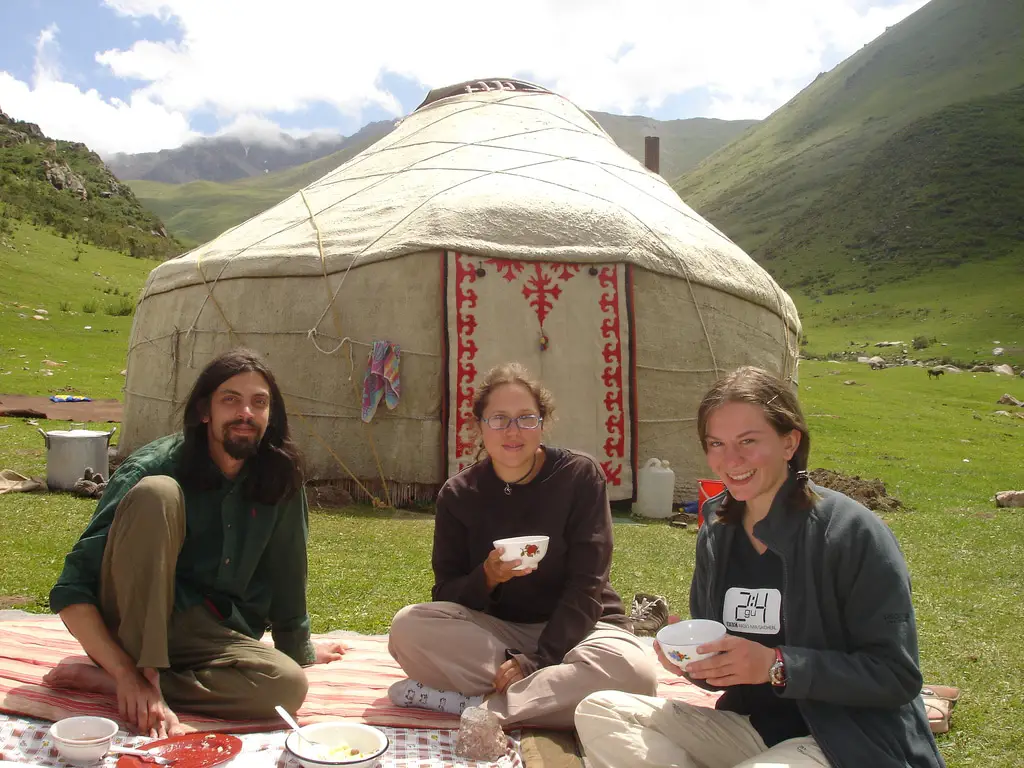
Yurt Construction and Design
Yurt construction is a multi-faceted process and thus tends to involve several people with specialized skills. The division of labor is today, as it always has been, relegated largely along lines of gender. Fathers will teach sons to build the wooden base. Mothers will teach daughters to make the felt coverings, woven tension bands, and decorations.
The yurt is a single circular room. As it often houses an entire Kyrgyz family, sometimes consisting of three generations, the room is often divided into four parts, sectioned off mostly by mental boundaries, in order to supply organization and something resembling personal space. Again, the division is by gender and traditional gender roles. To the left of the door is the where the men sleep and keep their hunting and riding gear. To the right is where the women and children sleep and where the kitchen utensils are kept. The third part of the yurt is in the middle section around the stove or fire. This is where the family comes together to eat meals and meet guests. The fourth part of the yurt, which overlaps with the third part, is the kitchen at the back of the yurt and which is the only section to be physically walled off (with a reed mat). Here, the women can prepare ingredients in privacy, and then bring them to the more public stove, where most meals are cooked in a large pot, or “kazan,” as it is known in Kyrgyz.
The major materials used to make a yurt are wood, reeds, and sheep wool. These are widely available to the nomadic herders of Kyrgyzstan. The supporting structure is made of wood. Wool and reeds provide considerable insulation from the elements.
The stove serves two purposes: to provide warmth; and to cook. While other fuels and technologies are now used, it is traditional to fire the stove with dried cow or sheep dung.
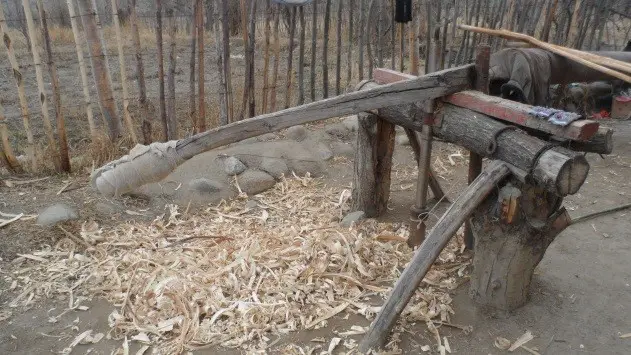
The construction of the yurt is compact and portable. The main structure is the base, constructed of wooden beams and called the “carcass” in Kyrgyz. The carcass is composed of four main components: the doorframe, the wall, the high ceiling, and the window. To construct these, logs are held in place with a large vice called the “tect” while the bark is scrapped off using a variety handmade double-handled knives, each with a shape specific to the component it helps create. Some logs which will need additional shaping are placed in large container of boiling water called the “par” for 15 minutes. Once they have softened and become more flexible, they are placed back in the tect for additional shaping and then left to dry in the sun. The beams will either dry in a triangular “teepee” shaped pile, or they will be stacked in a metal vise to help their curved form hold. Drying takes five or six days in the summer and longer in the colder winter months.
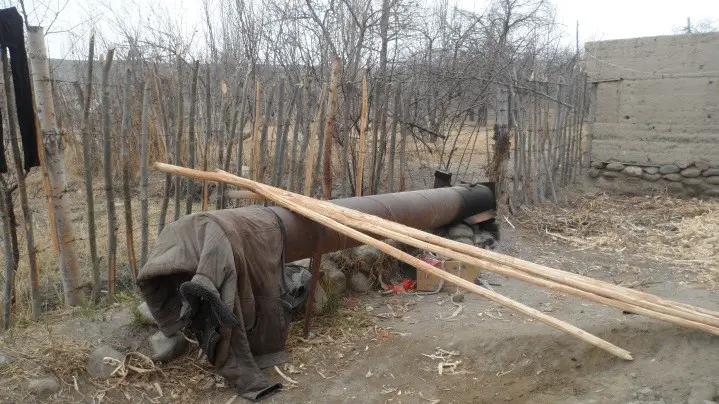
The par was introduced to yurt making only in the Soviet era, and was first brought to Kyzyl-Too by masters from Tokmok, a city near the Kyrgyz capital of Bishkek. Before the par, a process called “kik” was used. This involved mixing sheep feces and water together continuously for days, which created a thick, moist, and acidic mixture. The beams were placed in this mixture overnight to absorb the water and acid, making them flexible. The par reduces the time needed to achieve flexibility from several hours to several minutes. It obviously smells better as well.
Once dried, each component is carved down to its final shape and then usually painted. Over recent decades, red paint became traditional. However, a practice which is gaining popularity, which was also practiced long ago, is to paint the yurt a solid color of one’s choosing or even to leave the natural wood color. Lighter colors are becoming especially popular as they can make the inside of the yurt appear brighter and larger.
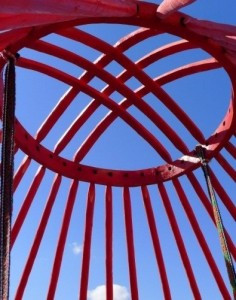
The first piece of the carcass to be assembled is the wall, or “kerege” in Kyrgyz. This piece is an overlapping web of long, flat beams that fold out like an accordion. Each beam is held together with rawhide strips called “gok,” which pierce both beams at each intersection. This design is easily collapsible, but also challenging to make, as each beam and each diamond-shaped opening must be of exactly equal size to function properly. The kerege is broken into two parts, the length of each depends on the desired size of the yurt.
The doorframe, or “bosogo tayak” in Kyrgyz, is assembled next. It is attached to the kerege with oromok that loop in and out of holes cut into the frame. Only the frame is put in at first, the door added towards the end.
The next piece is the “tunduk,” the crucial piece that is also figured on the Kyrgyz flag. “Tunduk” actually translates to “window” but could also be called the “crown” as it is the top of the yurt. It is also the most important: the tunduk holds the carcass together and without this crucial piece, the yurt would fall apart. It also allows sunlight in and smoke from the fire out.
The tunduk is a large wooden circle, with three arched beams running north-south, and three identical arched beams running east-west. This creates four squares in the middle, with twelve beams coming off those squares. Some people interpret the four squares to represent the four seasons, and the twelve beams as representing the 12 months in a year. There are other interpretations, but all agree that, in the end, the tunduk represents friendship, strength, and togetherness.

Making the circular shape of the tunduk takes skill and time. A thick log is first cut long ways and steamed in the par. Then, over the course of 15-20 days, the beam is tightened against a circular metal form until the beam achieves the desired shape. After this, the two ends of the beam are secured with two wooden joints to hold the circular shape in place. After the circle is secure, it is de-barked, cleaned, and carved into its final shape.
Pilot holes are then made around the outside of the tunduk. These are used to guide a heated iron rod which is forced through the wood to produce symmetrical square holes of the same shape and size as the ends of the ceiling beams, called “ook” in Kyrgyz. The tunduk, when placed on the kerege, must be lifted over the walls; it cannot go through the door. This heavy lifting is one reason why the carcass is considered a man’s realm. However, as we shall see later, the woman’s work can also be quite strenuous.
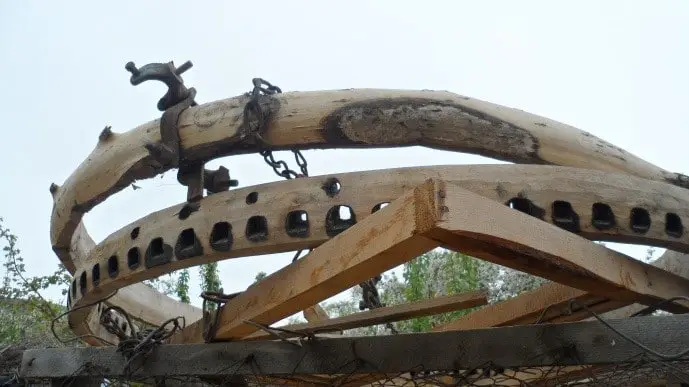
Once in place, the tunduk is temporarily supported by a long pole with a wide, flat top which will be removed after the ook are secure.

The number of ook in the yurt depends on the size desired; a small yurt will have about 65 ook, a medium yurt will have 75-85 ook, and a large yurt will have 90-100 ook. It is said that the number of ook also is an indicator of how many people can sleep in the yurt. A large 100 ook yurt should be able to sleep 100 people, though it might be a little cramped.
Once the carcass has been set up, it is then strengthened with tension bands called “ormok.” Two bands will be connected to the top and bottom of one side of the door, wrapped tightly around the circumference of the wall, and attached to the corresponding place on the other side of the door. Then another band will be looped around each ceiling beam. Still more bands connect the door to the wall. Still more will hold the felt covering in place after that is added.
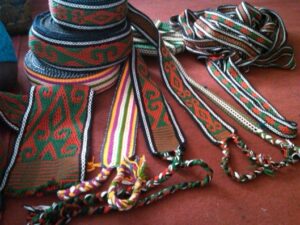
There are five types of ormok. All are made from woolen yarn and all woven by the women using a loom. Each type of ormok has a specific width, length, and function. The dimensions and design of the bands determine how long it takes to make them. A practiced weaver can produce about 22 feet of medium-width band in an average six-hour work day.
With the tension bands in place, the kerege can now support itself and the long pole in the center can be removed.
The wall and bands are then together covered with woven reed mats called “chi.” Chi provide additional insulation to the yurt. An additional chi covers the door and still another partially divides the kitchen from the rest of the yurt space.
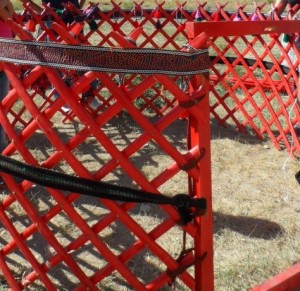
Chi are made by gathering reeds that grow in the fields or by the shores of lakes, rivers, or streams. They are cut to approximately uniform length and cleaned. Then, if desired, each reed is wrapped in colored wool for decoration. The reeds are then leaned against a long, waist-high beam in evenly spaced pairs. Designs are sometimes created by spacing out differently-colored pairs. The reed pairs are then bound together by weaving yarn between them. The yarn is then temporarily held down by rocks tied to each end. When available, instead of yarn to secure the reeds in place, sheepskin strips are used. One large sheep is needed to secure a full mat. Two mats, each about 26 feet long are needed to cover the wall of an average yurt.
Kyrgyz Felt Making and Design for Yurts
After the basic construction above has been completed, a felt covering known as “guise” in Kyrgyz will be secured to the outside. This covering protects the carcass from the elements and helps keep the space inside warm.

The first step in making felt is sheering the sheep. Sticks, dirt, and other impurities are picked out by hand. Then, the wool is evenly laid out on a chi. This step is the most important in the felt making process, because the quality of the completed felt depends on the evenness of the wool. The chi is then rolled as boiling water is poured over it. Afterwards, the chi is wrapped in a tarp and secured with rope, which makes it easier to carry to a special machine, where it is strapped in and which will beat the water out of the felt for 25 minutes. This machine is another modern innovation; before its arrival, felt makers stepped on the felt, beat it with their hands and forearms, and/or beat it with sticks to get the water out. This method took a lot longer and was very hard and potentially dangerous work, as the felt is steaming hot during the process. The machine thus allows felt, and thus yurts, to be more easily made on a commercial level.
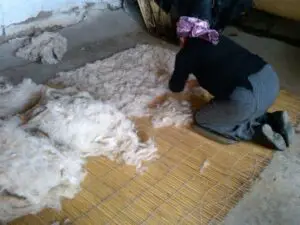
After 25 minutes, the felt is removed from the machine, unrolled, and turned to the opposite side. Then, it is rolled again and put back in the machine for another 25 minutes. Once complete, it is then removed, unrolled, and folded for cleaning. The cleaning process is fairly simple; buckets of cold water are poured over the folded felt until the water running through comes out clear. After hanging to dry for a day or two, the felt is rolled again and placed back into the machine for a final 25 minutes. The felt is then complete.
Typically eight rolls of felt, each about eight meters long, are used to cover the ook and five rolls cover the kerege, for a total of 13 rolls to create the full guise. To cover to ook, the rolls will be sewn together forming two parts, four rolls of felt in each part. Covering the kerege will be one long roll of felt, with all five felt rolls sewn together end-to-end.
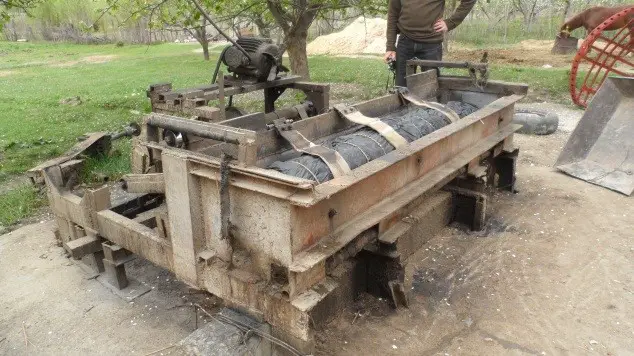
These felt pieces, once sewn, are never unstitched. When the yurt is disassembled, the pieces are taken whole, folded, and transported. They are attached to the kerege using more ormok.
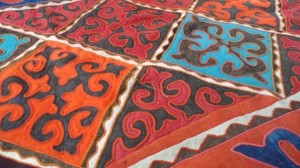
This same process is used to create felt to make “shyrdak,” the rugs that will further decorate and insulate the inside of the yurt. The felt is dyed, if desired, and cut into one of several traditional patterns. Each pattern has a name and a meaning; a skilled shyrdak master will know each. For example: the “ram’s horn” design is the “symbol for prosperity;” the “holy mother” design is the symbol of a “fairy protecting against various misfortune;” and the “crow’s claw” is the “symbol of leaving a trace.”
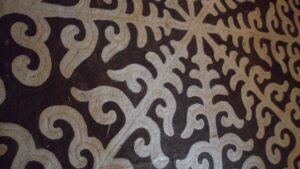
The design is cut and repeated as many times as desired. The mirror image of the design is cut from another color and then the colors are sewn together to serve as the top layer of the shyrdak. A second stitch will follow, securing the top layer to a thicker bottom layer of un-dyed, dark felt, which will help the rug last longer by helping keep the more ornate felt removed from the dirt and moisture in the ground below. Making the shyrdak is said to be the hardest and most time-consuming aspect of yurt making.
Another type of rug is called “ala guise,” which is not as difficult or time consuming to produce as the shyrdak rugs. Ala guise is made from just one layer of felt, although the one layer is two times as thick as an average piece of felt. The wool is layed down on the chi, forming a design and dyed before the starting the process of adding the boiling water to the wool. dyed while still on the chi before the felt is made.
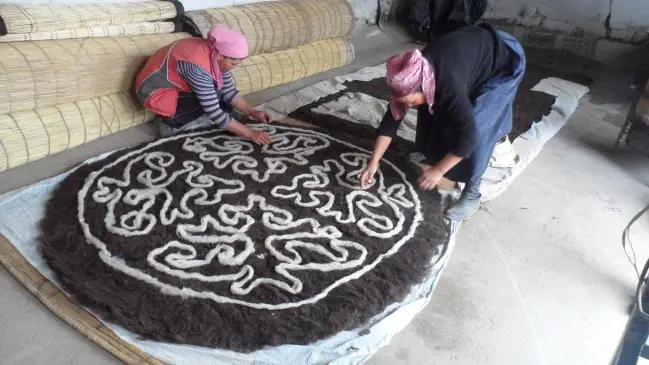
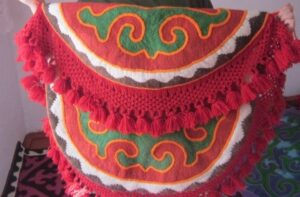
Another item made of felt or woven on a loom with thin rope of various colors (this rope is stronger and more durable than yarn), is the “ayak kap,” a large pocket that is hung on the kerege and used to hold kitchenware, clothes, sewing tools, and other household necessities.
Felt is a major part of Kyrgyz culture and tradition. In July 2012, Kyzyl-Too hosted “The World of Felt,” an annual three-day festival celebrating Kyrgyz culture and practices and, in particular, felt making. The festival was made possible in part by a grant from The Christensen Fund, a California-based charity devoted to globally “backing the stewards of cultural and biological diversity.” The specific grant given to the village, according the fund’s website, helps to “…support the mobilization of [Kyzyl-Too] village community (Issyk-Kul region, Kyrgyzstan) around felt culture, a community-based Felt Museum and an annual Felt Festival to re-establish connections between the land, ways of life, identity and culture.” Projects like The World of Felt Festival help bring people from around Kyrgyzstan and even internationally to this region of Kyrgyzstan to learn about or reconnect with local culture and traditions.
In an interview for the Christiansen Fund website, Aidai Asangulova, a felt maker from Kyzyl-Too and the founder of Min Kyial, a local organization of felt makers, states why she feels that felt tradition in Kyrgyzstan is important:
We need to preserve and further develop this tradition because Kyrgyzstan is ‘the heart of felt-making.’ Diverse felt-making technologies have been preserved in Kyrgyzstan. Where there are only one or two felt-making techniques in most felt-making countries, almost all felt-making methods are present in Kyrgyzstan. And someone in every household in our country knows how to make felt. If we fail to preserve and develop the felt-making tradition, we might lose much of it…
Decorating the Yurt – Final Touches
Other traditional decorations were once rarer additions and considered marks of a wealthy yurt owner. Today, most people purchasing yurts from the producers in Kyzyl-Too can afford them, however.
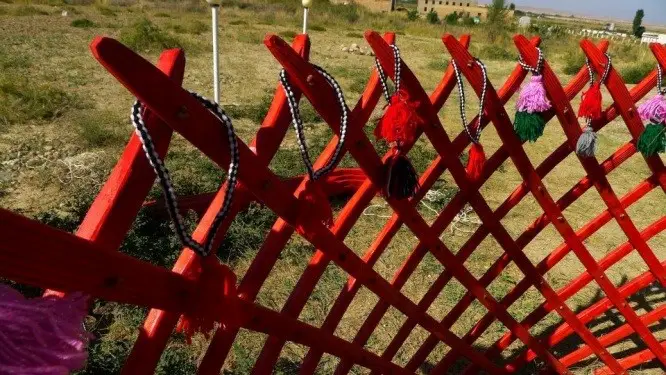
One of these purely decorative elements is the tassel. Traditional tassels come in two different sizes. The smaller are called “chachi,” which means “hair” in Kyrgyz. The chachi come in various colors and with either one or two tassels. They are made by hand-crocheting a thin piece of rope from yarn, then attaching the tassels at the middle and the ends of the rope, which are bound to create a loop. The chachi are placed where the kerege and the ook are tied together; if there are 100 ook, there will be 100 chachi.
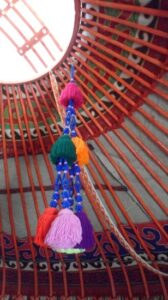
The larger tassel is called “chayan” and is hung from the ceiling of the yurt. Chayan are very long and come in pairs of two. To make these, a total of about 108 feet of rope is wrapped very tightly using about six large balls of yarn of various colors. Decorative knots are then tied into the wrapped rope. Seven tassels are created and attached to the rope by sewing a piece of felt into a long, thick tube to the desired spot and pushing a bundle of yarn through the tube. One tassel is placed at the top, two in the middle, and four at the bottom.
Another common decoration is a large, handmade tapestry, called “tush guise.” This decoration is made of two parts, a solid-color velvet or other material at the bottom, and an intricately-designed, multicolored, embroidered top. The elaborate design is very time consuming work and generally only entrusted to a skilled seamstress.
Conclusion
Throughout Kyrgyz history, tales were told about the beauty of yurts and yurts feature prominently in Kyrgyz folklore, history, and even political symbolism. In one of Kyrgyzstan’s other national treasures, an incredibly long epic poem about the great leader Manas who united the twelve Kyrgyz tribes into a nation, for instance, we read:
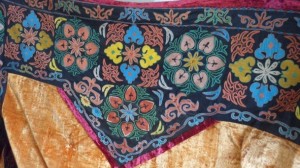
You look at her beauty! White, like snow, she was not felt, but cloth: the inside was covered in yellow paint, there were latticed walls; reed mats – all paid for with silk; around the yurt was tied fantastic beauty; When Manas entered the yurt, he was stunned by the luxury and beauty.
However, while some rural families still use yurts as their primary housing, owning a yurt is a privilege that not everyone can afford, especially as many Kyrgyz are now urbanized and use city apartments for housing. With the major changes that befell Kyrgyz culture throughout the Soviet era, through perestroika, and in the current era of political, regional, and ethnic tensions, the Kyrgyz are seeking to reestablish their national identity and ways that they can express it.
Kyrgyzstan’s culture has been seen as being in a crisis in recent years. As Jusaeva explained to me,
Our culture, in the 60’s and 70’s until the 80’s achieved a lot, in literature, movies, theatre, opera, ballet… Then, in the 90’s, when the Soviet Union fell, our culture fell. Now, it’s starting to come back again…Our Kyrgyz culture is becoming more important now than ever.
Thus, the explosion of the yurt building industry in the tiny village of Kyzyl-Too and the increased attention globally that Kyrgyzstan is now starting to receive represents not only a new economic resource for the village and country, but also a rebirth of sorts for the healthy expression of Kyrgyz culture, which starts and ends in a yurt.
Sources:
Abatbekova, Dinara. Personal interview. 28 Apr. 2013.
Abdikaparov, Koppar. Personal interview. 2 May. 2013.
Abdikoparov, Rustam. Personal interview. 13 May. 2013.
Akmatova, Svetkul. Shyrdak Dreams. Bishkek: Public Relations Department of The United States Embassy in Bishkek, 2008. Print.
Asangulova, Aida. “Looking at the World Through Felt Eye-Glasses.” Interview. Web log post. Christensen Fund. N.p., 26 Apr. 2013. Web. 15 May 2013. Website
Beishembaeva, Nurzat. Personal interview. 28 Apr. 2013.
Emonakoonov, Dulot. Personal interview. 28 Apr. 2013.
Grant, Kelli B. “10 Countries with Fastest Growing Tourism.” MarketWatch. N.p., 17 Mar. 2013. Web. 15 May 2013. Website.
Jumadilova, Nazgul. Personl interview. 20 April. 2013.
Jusaeva, Gulai. Personal interview. 24 Apr. 2013.
Kadirbekova, Aziza. Personal interview. 20 April. 2013.
Kairbekova, Elnura. Personal interview. 28 Apr. 2013.
SIAR Research and Consulting. “Survey of Tourism Market in Kyrgyzstan”. February 2013.
Takeshova, Aieda. Personal interview. 2 May. 2013.
Toksonbayeva, Gulbara. Personal interview. 3 May. 2013
Information Translated By:
Gabrielle Randall; Nurzat Beishembaeyva;
and Elnura Kairbekova
Pictures Taken By:
Gabrielle Randall; Sunshine Davis;
or as otherwise indicated

